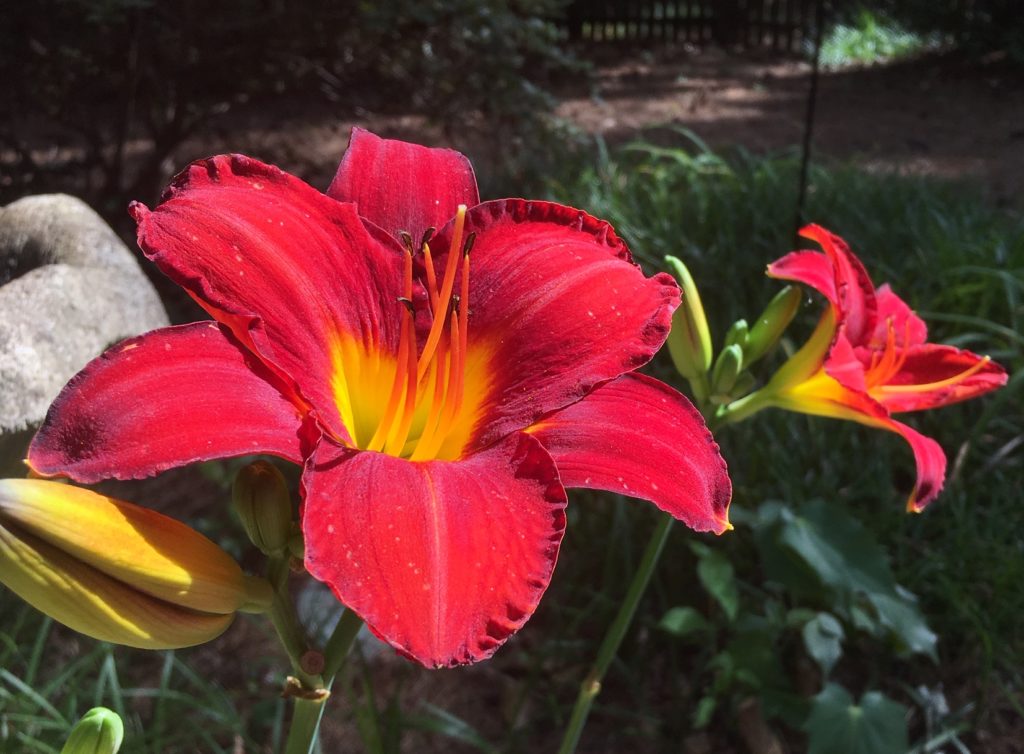
FIRECRACKER: This bright red daylily evokes the passion of Americans celebrating the July 4 holiday.
 NEWS BRIEFS: On the politics of abortion, immigration and more
NEWS BRIEFS: On the politics of abortion, immigration and more
COMMENTARY, Brack: February primary is still a long way away
SPOTLIGHT: Riley Institute at Furman University
MY TURN, Wilkerson: Investing in South Carolina’s health care workforce
FEEDBACK: Brack for president, more
MYSTERY PHOTO: Alternate view of Charleston site
S.C. ENCYCLOPEDIA: Mexican War and South Carolina
Editor’s Note: We offer abbreviated coverage this week to take advantage of the July 4 holiday.
NEWS BRIEFS
On the politics of abortion, immigration and more
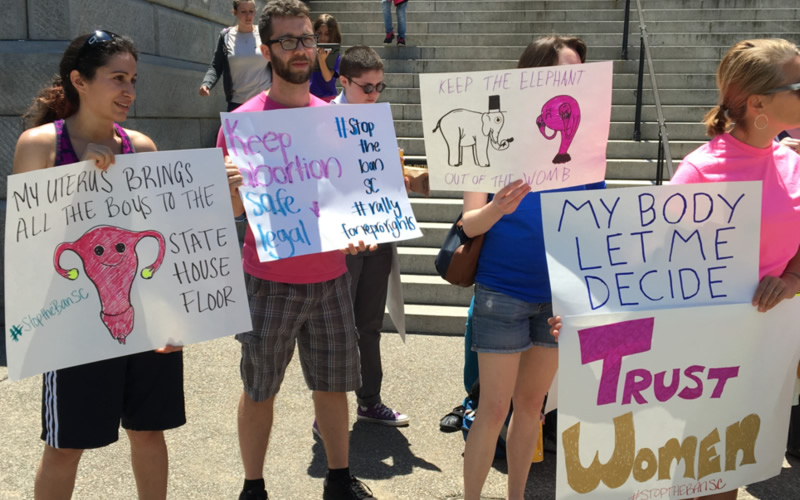
Staff reports | Here are some recent stories impacting South Carolina politics:
Politics of abortion cause behavior change. As politicos in South Carolina continue to grapple whether to approve a more restrictive abortion law, data show more women are seeking access to safe abortions out of the state, according to this story by The State. The number of abortions performed in the Palmetto State is half of what it was 20 years ago, but the overall number of S.C. women getting abortions is about the same — because they’re getting health care outside of the state, the story said.
- Here’s a link that offers a look at tough abortion bills under consideration.
- Meanwhile, Charleston restaurants are wading into the battle by having bake sales later this month. ‘
In other recent news:
![]() Immigration debate hits home. Protesters in Charleston are calling on U.S. Sen. Lindsey Graham, R-S.C., to demand closure of child detention centers in the news for having squalid conditions, according to WCSC. The Charleston protest was part of a national day of action to close camps. Highlighting how the issue might become part of the 2020 election in which Graham is running for another six-year term, protesters carried signs that said, “We will remember this in 2020.”
Immigration debate hits home. Protesters in Charleston are calling on U.S. Sen. Lindsey Graham, R-S.C., to demand closure of child detention centers in the news for having squalid conditions, according to WCSC. The Charleston protest was part of a national day of action to close camps. Highlighting how the issue might become part of the 2020 election in which Graham is running for another six-year term, protesters carried signs that said, “We will remember this in 2020.”
Harrison shows mettle. One of Graham’s Democratic opponents, Orangeburg native Jaime Harrison, raked in more than $1.5 million in second-quarter donations, surprising many political observers. The large cash haul highlights how Graham may be more vulnerable among a General Election electorate than previously thought. But to take on Graham, Harrison first has to beat Georgetown County native Gloria Bromell Tinubu, an educator and economist.
Santee Cooper picks new CEO. Mark Bonsall, a retired Arizona public power utility executive, has been tapped to be the next CEO of Santee Cooper, despite its shaky future. More.
New laws go into effect. A host of new laws on the books are now in effect, according to this story:
Pay raises. Some 32,000 state employees will get 2 percent pay raises, while 52,000 teachers will get an additional 4 percent. All totaled, increases will cost about $220 million in state funds.
Gas tax hike. As part of a deal a couple of years back to improve state roads, the state’s gas tax will go up an additional 2 cents per gallon. It will rise another 6 cents over the next three years.
Smaller college tuition hikes. The state is spending an additional $36 million to keep in-state tuition low.
New cabinet agency. As of July 1, the Department of Veteran Affairs is a cabinet-level agency reporting to the governor. Previously, it was a division in the Department of Administration.
2020 candidate calendar
 Throughout the presidential campaign season, we are working to keep South Carolina informed of candidate events in the state. Have an event you want us to know about? Email us at 2020news@statehousereport.com. In the coming days:
Throughout the presidential campaign season, we are working to keep South Carolina informed of candidate events in the state. Have an event you want us to know about? Email us at 2020news@statehousereport.com. In the coming days:
Biden to have town hall, more: Former Vice President Joe Biden will host a town hall at 3 p.m. Sunday in Charleston at the International Longshoremen’s Association hall on Morrison Avenue. The meeting is the second hosted by state Sen. Marlon Kimpson, D-Charleston. Biden also is expected to campaign Saturday in Sumter and Orangeburg. More.
Harris to make Pee Dee stops: U.S. Sen. Kamala Harris, D-California, will make her ninth stop to the Palmetto State with visits at 1 p.m. Sunday at Jerusalem Baptist Church, 301 S. 6th Street, in Hartsville, followed by a Florence town hall at 4:15 p.m. Sunday at New Ebenezer Baptist Church, SHEREC Building, 307 S. Ravenel St. Then at 12:30 p.m. Monday, she’ll have a town hall in Horry County at the Myrtle Beach Convention Center, 2101 N. Oak Street, in Myrtle Beach.
Looking ahead
Click below for other items coming up in the Statehouse:
Find any bill
- House bills
- Senate bills
- Have a comment? Send to: feedback@statehousereport.com
BRACK: February primary is still a long way away
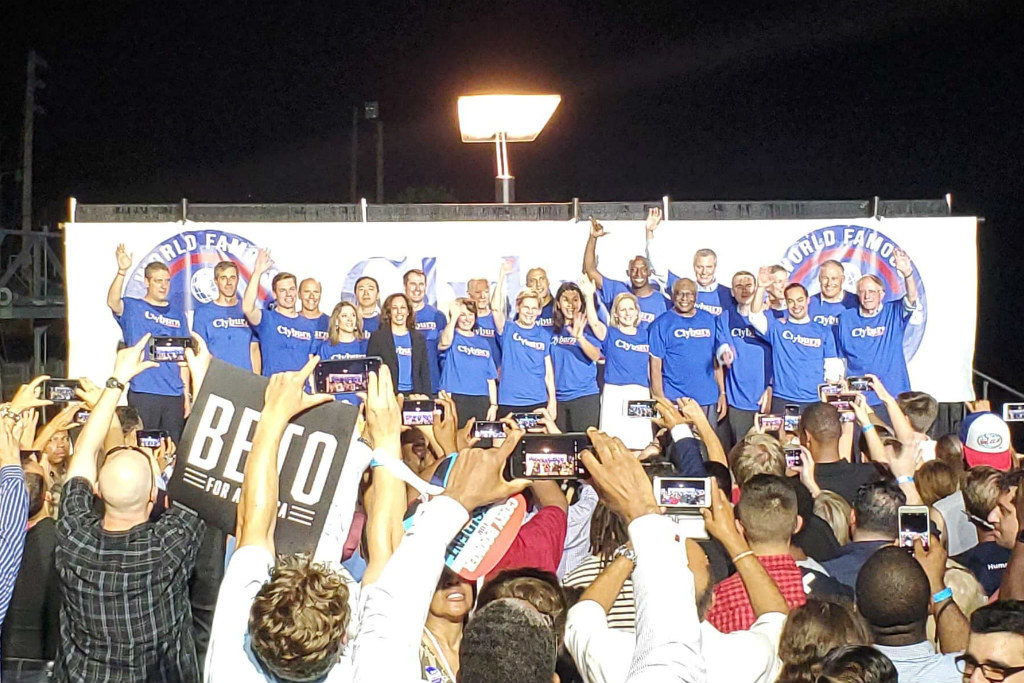
By Andy Brack, editor and publisher | An Australian journalist phoned the other day wanting a South Carolina take on the two recent Democratic presidential debates.
 “Didn’t watch the debates,” I said. “It’s all a little bit too early. There are eight months before the primary on Feb. 29, 2020. There’s more than enough time to make an informed choice.”
“Didn’t watch the debates,” I said. “It’s all a little bit too early. There are eight months before the primary on Feb. 29, 2020. There’s more than enough time to make an informed choice.”
Unfortunately, sensibly comparing candidates isn’t what’s driving most national media these days. Instead, most reporters are now locked in hyper-coverage mode for the foreseeable future. Just about anything in the news is being scrutinized through the lens of presidential politics. Likely translation: Nothing much nationally will get done between now and next November because everybody in Washington and on the campaign trail will be squabbling with each other.
Wouldn’t it be great if the entire campaign season could be done in a month or two like in countries that hold parliamentary elections? Then perhaps leaders could get on with the business of trying to figure ways out of the various messes in which the country finds itself.
So for now, look for South Carolina to continue to be in the media glare as Democratic presidential candidates duke it out to get noticed. Here are some reactions to what we’ve seen so far:
Joe Biden: The former vice president remains on top of the pack, despite incurring damage during a debate when U.S. Sen. Kamala Harris, D-Calif., decried how he worked decades ago with Southern senators known for being segregationists. He’ll get his juju back. And if he doesn’t, someone else will be the Democratic nominee.
Harris: Seen as a sharp, focused candidate with the precision of the prosecutor she was, Harris is riding high now. But the extra attention will draw the ire of President Trump, who will start withering criticism to punch her down. With eight months to go, she’ll sometime soon face the same kind of media descent that she just inflicted on Biden.
Bernie Sanders: He’s got a lot of loyal followers, but more people seem to be wondering whether he’s too old and why he’s running as a Democrat when he’s not one. He’ll hang in there, but he’s getting served now by …
Elizabeth Warren: The Massachusetts senator is on the rise as the candidate pushing practical ideas that can help all Americans, not just a few. Her insistent rollout of new policy positions is impacting the race and making other candidates be more precise about their visions for America. Another thing she’s got going for her among many Democrats: Trump really dislikes her and is probably threatened by her candidacy.
Pete Buttigieg: The South Bend mayor, whose rising star has been tarnished somewhat after a shooting in his Indiana city, may be the smartest candidate in the Democratic field. He’s raked in piles of money, which will allow his smart, engaging campaign to continue to be smart and engaging. Don’t write him off. (If he ended up being a vice presidential nominee, we can imagine the debate between him and his fellow Indianan, Mike Pence.)
Cory Booker: With a strong South Carolina organization, Booker knows he’s got to do well in the Palmetto State to be a national contender. There’s likely to be a breakout moment in the fall so keep an eye on what he’s talking about here. His challenge: To take his urban experience from New Jersey and have it translate in the suburbs and rural areas.
There are other Democratic contenders who offer promise. Former Texas Congressman Beto O’Rourke still seems to have rock star status, particularly among young voters. But they don’t vote in large numbers. Minnesota Sen. Amy Klobuchar may appeal to Midwestern voters, but she may not break out early because of the way primaries and caucuses occur. New York Sen. Kirsten Gillibrand has a feistiness that’s not getting much notice now, but that could change.
It’s still a long way until February 2020. There’s time for candidate waxing and waning. And there’s more than enough time for Trump or the Russians to do something that no one expects — and that may cause the ox of more than one candidate to run into a political ditch.
- Andy Brack’s new book, “We Can Do Better, South Carolina,” is now available in paperback via Amazon.
- Have a comment? Send to: feedback@statehousereport.com.
SPOTLIGHT: Riley Institute at Furman University
 The public spiritedness of our underwriters allows us to bring Statehouse Report to you at no cost. This week’s spotlighted underwriter is Furman University’s Riley Institute, which broadens student and community perspectives about issues critical
The public spiritedness of our underwriters allows us to bring Statehouse Report to you at no cost. This week’s spotlighted underwriter is Furman University’s Riley Institute, which broadens student and community perspectives about issues critical
to South Carolina’s progress. It builds and engages present and future leaders, creates and shares data-supported information about the state’s core challenges, and links the leadership body to sustainable solutions.
Launched in 1999, the Institute is named for former South Carolina Governor and former United StatesSecretary of Education Richard W. (Dick) Riley. It is committed to nonpartisanship in all it does and to a rhetoric-free, facts-based approach to change.
- Learn more about the Riley Institute.
- Also learn more about the Riley Institute’s Center for Education Policy and Leadership.
Wilkerson: Investing in South Carolina’s health care workforce

By Richard “Dick” Wilkerson, special to Statehouse Report | The needs of South Carolina’s health care industry are ever-changing. Our state must work towards eliminating health disparities currently experienced by rural and minority populations by strengthening the health care workforce within a values-based system of care.

How can we achieve this? The most efficient route is to start with the thousands of South Carolinans who make up our current workforce. Members of the health and human services workforce need to be empowered to perform as highly adaptive change agents, able to evolve with the pace of care delivery innovations and demands. Investing the time, resources, and research needed to transform the current and future workforce is key to improving overall population health throughout the Palmetto State.
In my decades of experience in business leadership, I can tell you that a healthy and empowered workforce in any industry will only lead to a more motivated and productive workforce.
Over the last year, I have been proud to help the South Carolina Institute of Medicine & Public Health (IMPH) lead these efforts by developing the Workforce for Health Taskforce and its report: The Evolving Health Workforce: Redefining Care Delivery in South Carolina.
Over the course of the last year, the taskforce has worked to recommend state specific policy changes and solutions that would create a sustainable and person-centered system of care in South Carolina.
The culmination of their research and collaborations with organizations like the South Carolina Hospital Association and the formed Prisma Health (formerly Greenville Health Systems and Palmetto Health) has been published in their recently released taskforce report. The report offers 16 tangible solutions on how elected officials as well as public and private stakeholders can invest and innovate and help move toward a more community-based approach to delivering care throughout South Carolina.
With the release of this report and related emerging work, South Carolina is well-positioned to be a national leader in population health. We invite you to learn more about how you can join our broader, collective work towards innovative statewide changes by visiting imph.org.
Wilkerson retired as the chairman and president of Michelin North America in 2011. He currently serves as a board member for the South Carolina Institute of Medicine & Public Health (IMPH), is the co-chair of IMPH’s South Carolina Health Care Workforce, and serves on the board of directors of Prisma Health.
- Have a comment? Send to: feedback@statehousereport.com.
Brack for president!
![]() To the editor:
To the editor:
Andy Brack for President! I nominate you for President and applaud you for speaking out (6/28: America’s got to stop wearing blinders). But who is listening….
— Jennifer Sharp, Beaufort, S.C.
Editor’s note: Thanks, but this is a job that we definitely do not want!
We’re conquerors, not immigrants
To the editor,
Just finished reading your article that was published in the Chronicle Independent. You are so wrong–on everything. I’m 52 years old and Trump is the best president by far, I just wish he would be more stern.
My family were not immigrants — they were conquerors. Colonialism is righteous, European culture is superior to all others. I have nothing in common with most of the people in America. The climate is changing, but so what? Thank God I’ve raised my children to see the atheist leftists for what they are.
— Brian Paul Witt, Kershaw County, S.C.
A good one that is a must-read
To the editor:
Not only a must-read article, a must-change list start here.
Let’s start with our separate and unequal Charleston County School District education outlined in the P&C’s “School board juggles short-term solutions for a decades-old problem in Charleston County.”
–– Fred Palm, Edisto Island, S.C.
Rush to ignorance via media people consume
To the editor:
“It is difficult to get a man to understand something, when his salary depends upon his not understanding it!” — Upton B Sinclair, 1937
The rush to ignorance is supported by the media that people consume. If one constantly hears how stupid and un-American those “pointy headed” intellectuals are, why wuold anyone want to be one?
In today’s Atlanta Journal-Constitution, Maureen Downey reports of a University of Virginia study that found that “teens in smaller, rural districts and low-income communities were less likely to do so. In looking at scores on benchmark tests of those students who didn’t take the SAT, the study identified some who would have scored high enough to qualify for Virginia’s top public campuses.”
I would like to see the correlation between this population and the media that set their expectations.
— J.J. Hayden, Covington, Ga.
Send us your thoughts … or rants
We love hearing from our readers and encourage you to share your opinions. But you’ve got to provide us with contact information so we can verify your letters. Letters to the editor are published weekly. We reserve the right to edit for length and clarity. Comments are limited to 250 words or less. Please include your name and contact information.
- Send your letters or comments to: feedback@statehousereport.com
Alternate view of Charleston site
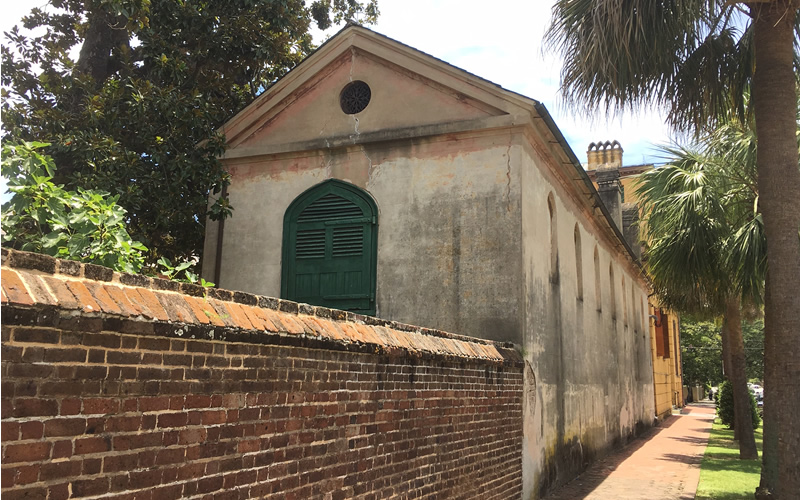
Here’s a different view of a site you may have seen when visiting Charleston. You may not have seen it from this angle. This week for the gold, where and what is it? Send your guess about the location of this photo to feedback@statehousereport.com. And don’t forget to include your name and the town in which you live.
Our previous Mystery Photo
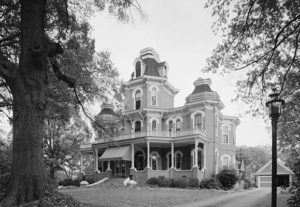 Our June 28 mystery, “Grand house” showed the beautiful Lanneau-Norwood House, located at 417 Belmont Avenue in Greenville. Built in 1877, it is a 2 1/2-story, brick Second Empire-style mansion with a Mansard roof.
Our June 28 mystery, “Grand house” showed the beautiful Lanneau-Norwood House, located at 417 Belmont Avenue in Greenville. Built in 1877, it is a 2 1/2-story, brick Second Empire-style mansion with a Mansard roof.
Congratulations to several readers who correctly identified the mansion: George Graf of Palmyra, Va.; Jay Altman of Columbia; Bill Segars of Hartsville; Dale Rhodes of Richmond, Va.; Ashley Aldebol of Greenville; and Frank Bouknight of Summerville.
Graf gave context pulled from Wikipedia: “The Lanneau-Norwood House (“Alta Vista”) is a historic house, built c. 1877 by Jacob W. Cagle (1832–1910) for capitalist Charles Henry Lanneau II (1834-1913). Lanneau, was a veteran of Hampton’s Legion which was an American Civil War military unit of the Confederate States of America, organized and partially financed by wealthy South Carolina planter Wade Hampton III. Hampton’s Legion initially boasted a large number of South Carolina’s leading citizens, including future generals J. Johnston Pettigrew, Stephen Dill Lee, Martin W. Gary, and Matthew C. Butler. The Wade Hampton statue currently resides on the South Carolina Statehouse lawn.”
Bouknight added, “After the Civil War, Lanneau, a veteran of Hampton’s Legion, first worked as a bookkeeper for Camperdown Mill and then in 1882 organized Huguenot Mill, one of the first steam-powered textile mills in Upstate South Carolina. Perhaps with money inherited by his first wife, Lanneau was able to build a fashionable and unusually grand residence for contemporary Greenville. After a major fire in 1883, Lanneau rebuilt the house, which burned again in the 1890s.
“Bankrupt by 1907, Lanneau sold the house to banker and textile financier John Wilkins Norwood, a relative by marriage. Norwood added plumbing, electricity, and a coal furnace and furnished it with drapes, tapestries, and furniture suggested by decorators from Wanamaker’s in New York. At Norwood’s death in 1945, the house passed to his son-in-law and daughter, Claud Sapp and Frances Norwood Funderburk, and then to their son and daughter-in-law George Norwood and Ann Downen Funderburk, who took special interest in the gardens.”
- Send us a mystery: If you have a photo that you believe will stump readers, send it along (but make sure to tell us what it is because it may stump us too!) Send to: feedback@statehousereport.com and mark it as a photo submission. Thanks.
S.C. ENCYCLOPEDIA
HISTORY: Mexican War and South Carolina
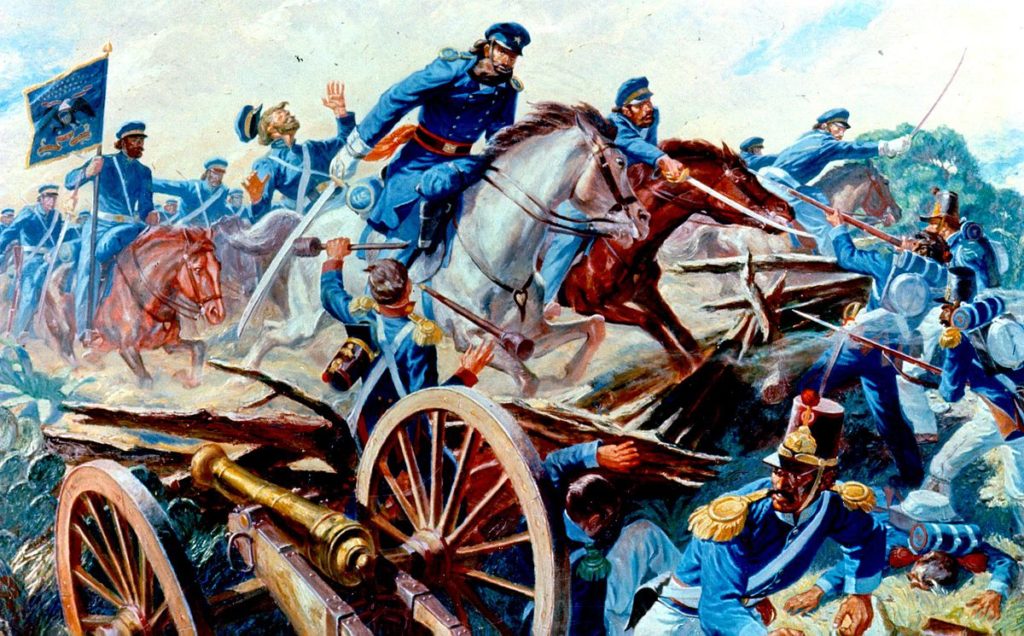
S.C. Encyclopedia | The roots of the Mexican War can be traced to westward expansion following the War of 1812. Many Americans, including many South Carolinians migrating west in search of cheap land, settled in northern Mexico where liberal land grants of as much as four thousand acres were available. These settlers established an agrarian economy based on slavery.
The 1836 revolt that led to the de facto independence of Texas set the stage for future conflict with Mexico. Texas statehood, supported by most South Carolinians, became mired in sectional controversy and was rejected in June 1844. However, in the 1844 presidential campaign James K. Polk ran on a platform of “recovering” lost territories, including Texas. Polk won, but before he was inaugurated, the out-going president, John Tyler, engineered a proposal for Texas statehood, which was accepted by Texas on July 4, 1845.
To “protect” our newest state, President Polk sent Zachary Taylor and nearly half the U.S. Army into Texas, raising tensions when he ordered Taylor into territory claimed by Mexico along the Rio Grande. Hostilities began on April 25, 1846, when Mexican forces ambushed a patrol led by Captain Seth B. Thornton. Polk quickly sought a declaration of war and money and men to reinforce Taylor.
In South Carolina public opinion on the war was mixed. John C. Calhoun fervently opposed the war, believing it posed a grave danger to southern political power, but he was placed in a difficult position by the coupling of the war declaration with provisions for supporting Taylor’s army. In the end he abstained from voting on the bill. The editor of the Charleston Mercury was highly critical of Polk and defended Calhoun’s position. Many other South Carolina newspapers criticized the administration’s position as well. On the other hand, the Abbeville Banner and the Greenville Mountaineer advocated stern measures, including invasion of Mexico. Taylor’s victories in northern Mexico muted the opposition. War fever swept the state.
When South Carolina was asked to provide a volunteer regiment, state adjutant general James W. Cantey ignored the fact that the regiment was for the reserve when he issued his guidelines on May 29. His optimistic deadline of June 10 was not met, and it was not until June 29 that ten companies were accepted for service. The news from Secretary of War William Marcy in July that the Palmettos were not needed was devastating.
In August 1846 the Wilmot Proviso, a failed attempt by Pennsylvania congressman David Wilmot to prohibit slavery in any territory acquired from Mexico, caused little reaction in South Carolina, and there was increasing public support for the war. Even the editor of the Mercury, while fulminating against northern warmongers, opposed withdrawing Taylor’s army from northern Mexico.
That autumn the administration’s optimistic view of the war collided with Mexico’s intransigence, and on November 16 South Carolina was asked to provide a regiment for immediate service. Because the term of service had changed from one year to the duration of the war, the Palmetto Regiment had to be reformed, and many refused to volunteer under the new provisions. In Greenville, for example, where two companies had been formed in June, only forty-two men volunteered and a company could not be formed. War fever had died down in the upstate and on the coast, and except for a company from Charleston, the Palmetto Regiment was raised exclusively in the Midlands.
As the Palmetto Regiment marched to war in 1847, the Wilmot Proviso was being roundly condemned in the South Carolina press. Calhoun, for example, feared that such abolitionist pressure would exacerbate sectional rivalry in the near future. Many agreed. Despite this debate, South Carolinians eagerly anticipated news of the war. Some in the Palmetto Regiment corresponded with their hometown newspapers, and their reports of the battles created intense interest in South Carolina. People wanted to know what “our boys” were doing.
When peace came in February 1848 there was a clamor for the return of the volunteers. The surviving Palmetto Regiment finally arrived at Mobile, Alabama, in late June 1848. There they were mustered out and left to find their own way home. The return of the Palmettos generated great excitement in South Carolina. Columbia and Charleston got into a heated debate over which city would “officially” welcome the regiment home. In the end there was a grand celebration in Columbia on July 26 and an equally grand one in Charleston two days later. However, by the end of the year the war with Mexico was all but forgotten.
— Excerpted from an entry by Jack Allen Meyer. his entry may not have been updated since 2006. To read more about this or 2,000 other entries about South Carolina, check out The South Carolina Encyclopedia, published in 2006 by USC Press. (Information used by permission.)
Available in paperbrack, err, paperback
 Now you can get a copy of editor and publisher Andy Brack’s We Can Do Better, South Carolina! ($14.99) as a paperback.
Now you can get a copy of editor and publisher Andy Brack’s We Can Do Better, South Carolina! ($14.99) as a paperback.
The book of essays offers incisive commentaries by editor and publisher Andy Brack on the American South, the common good and interesting South Carolina leaders, such as former U.S. Sen. Fritz Hollings, civil rights advocate Septima Clark, former S.C. Gov. David Beasley and more. There also are discussions on civil rights struggles with which the Palmetto State continues to grapple. as well as commentaries on politics, governments, the hangovers of South Carolina’s past and her future opportunities.
We Can Do Better, South Carolina! is also available exclusively as a Kindle book for $7.99. Click here to purchase a Kindle copy.
- If you have a comment or questions about the book, please let us know at: feedback@statehousereport.com.
ABOUT STATEHOUSE REPORT
Statehouse Report, founded in 2001 as a weekly legislative forecast that informs readers about what is going to happen in South Carolina politics and policy, is provided to you at no charge every Friday.
Meet our team
- Editor and publisher: Andy Brack, 843.670.3996
- Statehouse correspondent: Lindsay Street
More
- Mailing address: Send inquiries by mail to: P.O. Box 22261, Charleston, SC 29407
- Subscriptions are free: Click to subscribe.
- We hope you’ll keep receiving the great news and information from Statehouse Report, but if you need to unsubscribe, go to the bottom of the weekly email issue and follow the instructions.
- © 2019, Statehouse Report. All rights reserved.
















